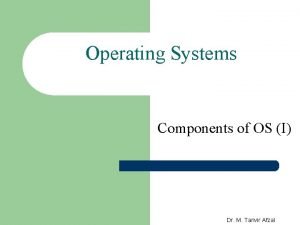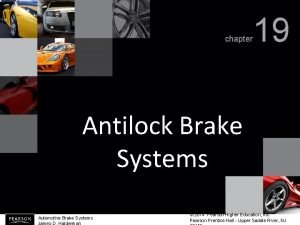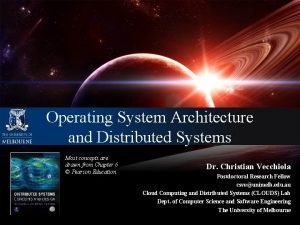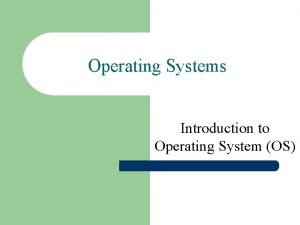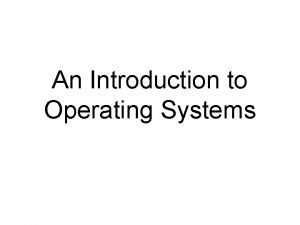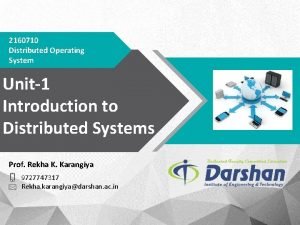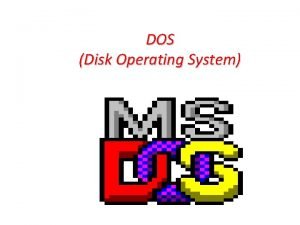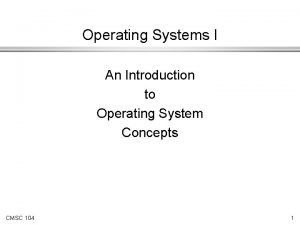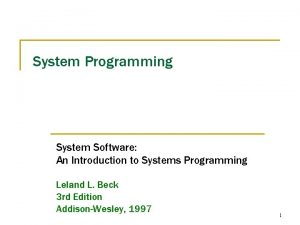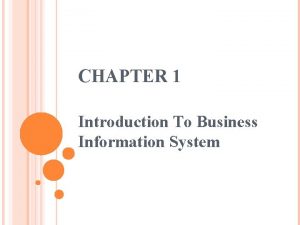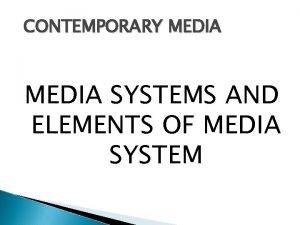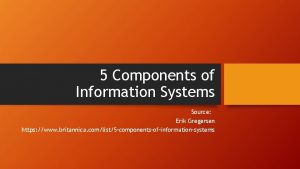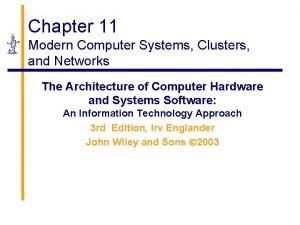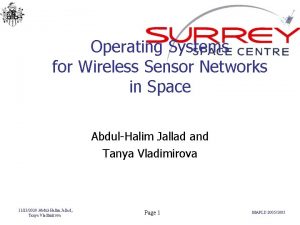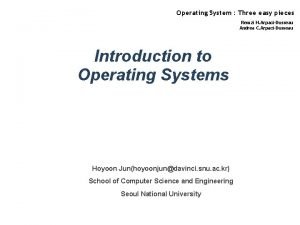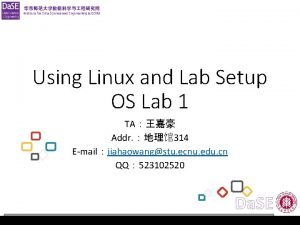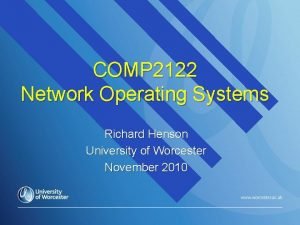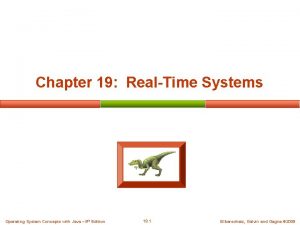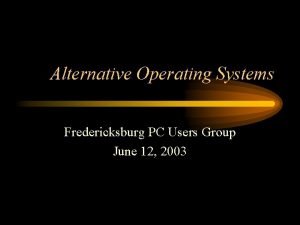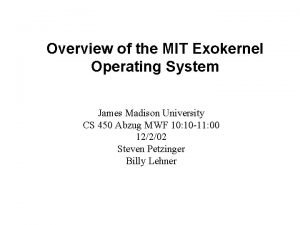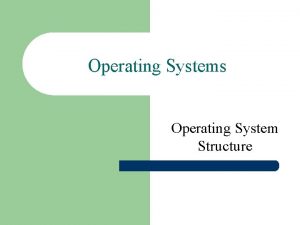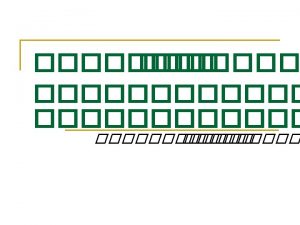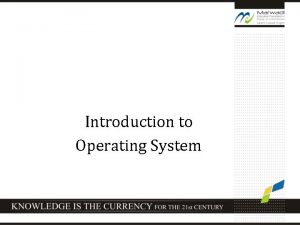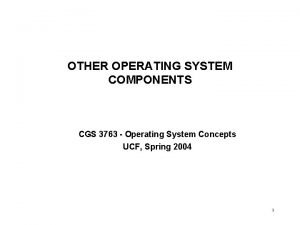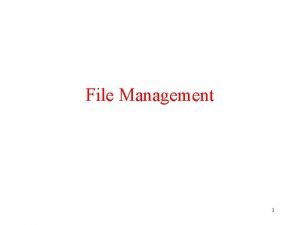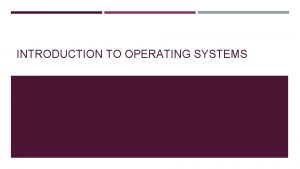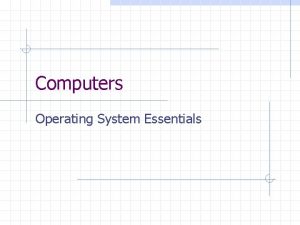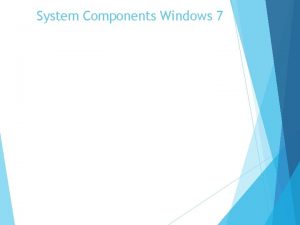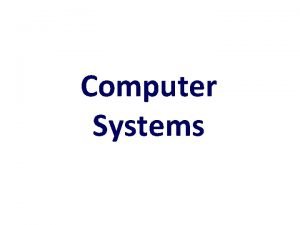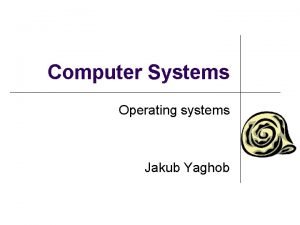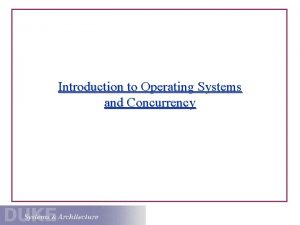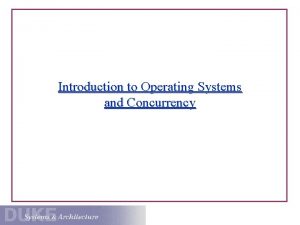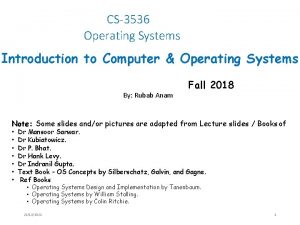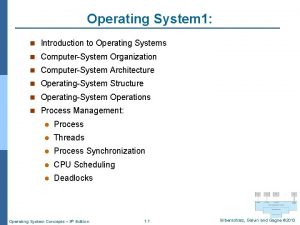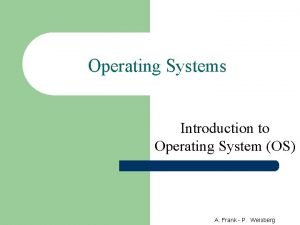Operating Systems Introduction to Operating System OS Components

































- Slides: 33

Operating Systems Introduction to Operating System (OS)

Components of a Computer System

Components of a Computer System Contd… • Hardware – provides basic computing resources like CPU, memory, I/O devices. • Operating system – OS controls and coordinates the use of the hardware among the various application programs for different users. • Applications programs – They define the ways in which the system resources are used to solve the computing problems of the users. • Users (people, machines, other computers).

What is OS? • Operating System is a software, which makes a computer to actually work. • It is the software that enables all the programs we use. • The OS organizes and controls the hardware. • OS acts as an interface between the application programs and the machine hardware. • Examples: Windows, Linux, Unix and Mac OS, etc. ,

USER View of OS • Ease to use • Efficient resource utilization

SYSTEM view of OS • OS is a resource allocator Manages all resources (CPU time, memory space, storage space, I/O and so on) Decides between conflicting requests for efficient and fair resource use • OS is a control program Controls execution of programs to prevent errors and improper use of the computer

Evolution of OS § § § Batch Processing Multiprogramming Timesharing

Batch Processing • Early computers were extremely expensive – Important to maximize processor utilization • Monitor – Software that controls the sequence of events – Batch jobs together – Program returns control to monitor when finished

Batch Processing (Contd…) • The interface to the monitor was accomplished through Job Control Language (JCL). • For example, a JCL request could be to run the compiler for a particular programming language, then to link and load the program, then to run the user program.

Batch Processing (Contd…) Hardware features: § Memory protection: protect the memory area containing the monitor from the Utilities § Timer: prevents a job from monopolizing the system Problems: § Bad utilization of CPU time - the processor stays idle while I/O devices are in use.

Multiprogramming • Multiprogramming is a technique to execute number of programs simultaneously by a single processor. • Number of processes reside in main memory at a time. • The OS picks and begins to execute one of the jobs in the main memory. • If any I/O wait happened in a process, then CPU switches from that job to another job. • Hence CPU in not idle at any time.

Multiprogramming (Contd…) • Processor must wait for I/O instruction to complete before preceding

Multiprogramming (Contd…) • When one job needs to wait for I/O, the processor can switch to the other job

Multiprogramming (Contd…)

Multiprogramming (Contd…) OS Job 1 Job 2 Job 3 Job 4 Job 5 Advantages Efficient memory utilization Throughput increases CPU is never idle, so performance increases.

Time Sharing Systems • Multiprogramming systems : several programs use the computer system • Time-sharing systems : several (human) users use the computer system interactively • Characteristics: § Using multiprogramming to handle multiple interactive jobs § Processor’s time is shared among multiple users § Multiple users simultaneously access the system through terminals •

Time Sharing Systems (Contd…) • Time sharing, or multitasking, is a logical extension of multiprogramming • Multiple jobs are executed by switching the CPU between them • In this, the CPU time is shared by different processes, so it is called as “Time sharing Systems”. • Time slice is defined by the OS, for sharing CPU time between processes. • Examples: Multics, Unix, etc. ,

Time Sharing Systems (Contd…) Multiprogramming Time Sharing Principal objective Maximize processor Minimize response use time Source of directives Job control language Commands entered to operating system commands provided at the terminal with the job

Types of OS Operating System can also be classified as • Single User Systems • Multi User Systems

Single User Systems • Provides a platform for only one user at a time. • They are popularly associated with Desk Top operating system which run on standalone systems where no user accounts are required. • Example: DOS

MS-DOS execution (a) At system startup (b) running a program

Multi-User Systems • Provides regulated access for a number of users by maintaining a database of known users. • Refers to computer systems that support two or more simultaneous users. • Another term for multi-user is time sharing. • Ex: All mainframes and are multi-user systems. • Example: Unix

Operating System Services The following are the services provided by the operating system. • User Interface • Program Execution • I/O Operations • File-system manipulation • Communications

Operating System Services (Contd…) § Error Detection § Resource Allocation § Accounting § Protection

User Interface § User interface - Almost all operating systems have a user interface (UI) • A user interface controls how to enter data and instructions and how information is displayed on the screen – With a graphical user interface (GUI), user interacts with menus and visual images – With a command-line interface, a user uses the keyboard to enter data and instructions

Program Execution § Operating system must be able to load a program into memory and to run that program. § The program must be able to end its execution, either normally or abnormally.

I/O Operations • A running program may require I/O, which may involve a file or an I/O device

File-System Manipulation § Programs need to read and write files and directories § The operating system handles the process of creating, deleting and searching files § Also list file Information, permission management

Communication § Every process needs to exchange information with another process § Communications may be implemented via shared memory or by the technique of message passing § Communications occurs in two ways • Within processes executing on the same computer • Between processes executing on different computers, tied together by a network

Error Detection § Errors can happen at any time in the system § Errors can occur in the CPU, memory, I/O Devices, and in the user program § For each type of error, OS should take the appropriate action to ensure correct and consistent computing § Debugging facilities can greatly enhance the user’s and programmer’s abilities to efficiently use the system

Resource Allocation § Multiple jobs run at the same time so resources must be allocated to each one of them § Many different types of resources are managed by the operating system § Some (such as CPU cycles, main memory, and file storage) have special allocation code, whereas others (such as I/O devices) have general request and release code § The operating systems have various routines for different jobs in the system, for example CPU scheduling

Accounting § Need to keep track of number and type of resources allocated to processes/users § This tracking of user information can be used to find out the usage statistics. § These usage statistics are useful for the researchers who wish to re-configure the system to improve computing services.

Protection § Protection and Security is an important issue in multi-user computer systems. § Protection involves in ensuring that all access to system resources is controlled. § Security of the system requires user authentication, extends to defend external I/O devices from invalid access attempts § Access to the resources must be authenticated with a password.
 Components of an operating system
Components of an operating system Os components
Os components File management components
File management components Components of operating system
Components of operating system Open source operating system
Open source operating system Kelsey-hayes abs schematic
Kelsey-hayes abs schematic Os architecture
Os architecture Slidetodoc.com
Slidetodoc.com Operating system definition
Operating system definition Operating system
Operating system Dos internal and external commands
Dos internal and external commands Os
Os System software: an introduction to systems programming
System software: an introduction to systems programming 6 components of the personalised care operating model
6 components of the personalised care operating model Buddy system operating system
Buddy system operating system File system in operating system
File system in operating system File system in operating system
File system in operating system File system in operating system
File system in operating system Components of information systems
Components of information systems Types of media systems
Types of media systems 5 components of is
5 components of is Computer systems components
Computer systems components Operating system and example
Operating system and example Evolution of operating systems
Evolution of operating systems Wsn operating systems
Wsn operating systems Remzi os
Remzi os Operating systems lab
Operating systems lab Modern operating systems tanenbaum
Modern operating systems tanenbaum Design issues of distributed file system
Design issues of distributed file system Early operating systems
Early operating systems Real-time operating systems
Real-time operating systems Can we make operating systems reliable and secure
Can we make operating systems reliable and secure Alternative operating systems
Alternative operating systems Mit operating system
Mit operating system



